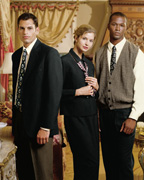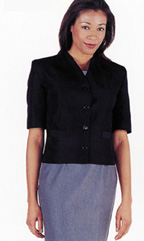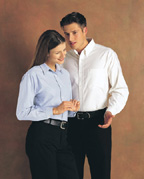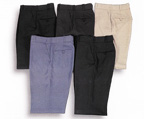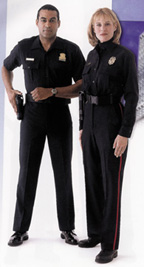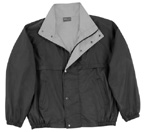|
“Don’t look now,” says Peter Genovese of Newhouse News Service, “but Generation X is on its way to becoming Generation XL.” Maybe we’re already there. Fifty-five percent of Americans are now, by medical standards, overweight or obese. In five years, the number is expected to balloon to 70 percent. The average American man is now seven pounds heavier than he was a decade ago, and the average American woman is 5 feet 31/2 inches and weighs 152 pounds. Perhaps the most visible poster child for the New American Waist Land is Oprah Winfrey, whom millions of people have watched yo-yo anywhere between 142 and 237 pounds over the last few years. Almost 40 percent of women in a recent survey said they personally relate to her struggle because of their own. Muscled in between is another category entirely: Men and women so dedicated to fitness and working out that a whole new physiognomy, the Super Bodybuilder, has emerged. Men in particular develop such disproportionately large biceps, chests and thighs that they can no longer fit into normally proportioned clothing. What does all this mean, especially to the uniform industry? In the first place, it means a big demand for a whole new size range. Many companies have seen their average women’s size go from a 10 or 12 to a 14 or 16, and the average men’s size move up from medium to large or extra-large. At Tri-Mountain, the number one selling size has swelled from XL to 2XL in the last two years, and the company now carries men’s sizes from XS to 6XL Tall and women’s sizes to 4X. “People are looking for bigger and bigger sizes, and we’ve had to offer a much greater selection. Now our clients are very happy with our size range,” says Jessica Fernandez. The introduction of bullet proof vests was the first upsizing Southeastern Shirt saw, when customers had to bump up to the next size to accommodate them. “But now we’re seeing bigger and bigger sizes more and more,” says Ed Straight. “Our average for men used to be 15 to 161/2, and now 171/2 and 181/2 are our biggest sellers. For women, most of our sales are for bust sizes 36 to 50.” Southeastern now carries men’s shirts to size 20, women’s shirts to size 46, and women’s trousers up to a size 26. The enormity of the situation has Straight perplexed but responding quickly. “We got a call to do a custom design for a 450-pound emergency medical technician in Florida, which I thought was pretty unusual,” he says. “But the very next day, I got the exact, same request from somebody in Pennsylvania. I can’t explain it, but we’re dealing with it. Now, it seems like we’re doing very large custom sizes every day. Give me the measurements, and I’ll make you something that looks good.” The industries a manufacturer serves may determine how much they need to respond to the supersizing of America. According to Larry MacDonald of Edwards Garment, the largest sizes are being requested for lower income jobs, like security guards and bus drivers. Andrew Foss of Elbeco Incorporated agrees, with their largest sizes now being requested by the public transportation and postal industries. Southeastern Shirt is upsizing for the public safety sector, including police, fire departments and emergency medical technicians, as well as the trucking, postal and security industries. Tri-Mountain has seen an expansion in size across all industries they serve. Employment level or age, not the industry, is a more accurate predictor of size for Martin’s Uniforms, and they seem to be outfitting more Ally McBeals. “Some jobs are held by younger people, and we’re definitely seeing smaller sizes there. Most programs start at size 4 or 6 for women, but we’re getting more calls for size 2,” says Peggy Klein. It’s become obvious that the uniform industry has to size up America in a whole new way, and manufacturers are responding innovatively to meet the growing needs of their particular client base, from new designs to new patterns to new fabrics. According to Elbeco Incorporated, a pioneer that moved the industry toward female sizing, population resizing heralds a whole new trend. Public safety uniforms were originally designed and sized to military proportions, the “traditional fit,” which made for a crisp fit but a very uncomfortable day. Next came the “relaxed fit,” with more room in the seat and thighs. “Now we’re going to a ‘comfort cut,’ ” says Andrew Foss, “designed in response to the need for more functionality in very active jobs. It’s changing the way we look at design as well as well as fabrics.” Some companies have responded to the big challenge by reshaping their best-selling designs. “We’ve relaxed our fit and adjusted our size scales on a variety of styles to meet these changes,” says Janet Rives of Red Kap, who notes the average chest size in overalls jumps from 42 to 46. “Our full-cut industrial pant is perfect for body- builders and other hard-to-fit types who need the extra room. And we’ve oversized and relaxed our JT22 jacket.” Others are cutting differently. “Once women hit a size 16 or 18, their body shape tends to be very different from a smaller-sized woman,” says Larry MacDonald of Edwards Garment. “We cut two very different patterns, one for women sized 4 to 16, another for women sized 18 to 28.” Executive Apparel is doing the same thing. “We’ve established a new pattern for the size 18 to 30 female. We believe she has totally different dimensions than the customer below size 18, and needs to be addressed with separate grade rules,” says Donald Singer. Because a man or woman in a uniform has to look good as well as feel good, manufacturers are reconsidering what best flatters the new range of body types. “We’re resizing our skirts and slacks, but we’re also taking some pleated and dirndl skirts out of our line, and going to some sleeker, more slimming looks,” says Larry MacDonald of Edwards Garment. Executive Apparel recommends some of their double-breasted blazers to larger-size customers, other styles to smaller, slimmer ones. Says Donald Singer, “We are very committed to designing different products for different sizes. Each body type has different needs.” Southeastern Shirt isn’t cutting any new shirt patterns, just making them bigger, says Ed Straight. “We’ve chosen not to go the new pattern route. But we custom make orders–trousers to accommodate big thighs–for example,” he says. To serve body builders, Martin’s has created new, more generous designs for supersize thighs. “The pleated trouser, rather than plain front, works much better for them, and we cut patterns accordingly,” says Peggy Klein. “And for women, slim skirts are really only flattering to the smaller figure, so we have to move to other styles for fuller figured women. We’ve started thinking differently about the whole program now, based on job performance, comfort and care.” The ready-to-wear industry can create confusion and illuminate sensitivities. High end designers in particular size very differently from the uniform industry, encouraging women to think they’re more Ally McBealesque than they really are. So a woman who can slip into an ego-flattering size 6 designer dress is often shocked and appalled to find that she needs a size 12 uniform. “Believe me, she’ll have a very negative reaction to that,” says Larry MacDonald of Edwards Garment. But Elbeco is taking a bit of a cue from that designer psychology. Elbeco’s new Duty-Plus trousers now have a stretch element in the fabrication, and an elastic waistband that can accommodate up to two size changes. “So size 36 also fits a size 38. There’s a lot of denial going on out there,” says Andrew Foss, smiling. The industry also finds itself running to keep pace with a range of inventory requests the likes of which it’s never seen. “We try to keep all sizes in stock, so we have to have much more in inventory than ever before. We now have three warehouses,” says Jessica Fernandez of Tri-Mountain, who says manufacturing lead times have also been affected. “No matter how much we raise the inventory on bigger sizes, we always run out. They go first, and no matter how much we carry, it seems like it’s never enough. I’m simply amazed,” according to Ed Straight of Southeastern Shirt. And Peggy Klein of Martin’s agrees: “We find we have to watch our inventory and forecasting very carefully now. Our numbers are constantly assessed.” Whatever the shape of the future may be, the opportunity for the industry is to help people look good and feel good in their jobs, no matter what the tape measure says. “You know that old saying,” says Larry MacDonald of Edwards Garment. “I’m not fat! I’m just too short for my size.” |
|
| Above story first appeared in MADE TO MEASURE Magazine, Fall & Winter 2001 issue. All rights reserved. Photos appear by special permission. | |
| Halper Publishing Company 633 Skokie Blvd, #490 Northbrook, IL 60062 (847) 780-2900 Fax (224) 406-8850 [email protected] |
|




